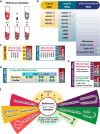Targeted DNA-seq and RNA-seq of Reference Samples with Short-read and Long-read Sequencing
- PMID: 39152166
- PMCID: PMC11329654
- DOI: 10.1038/s41597-024-03741-y
Targeted DNA-seq and RNA-seq of Reference Samples with Short-read and Long-read Sequencing
Abstract
Next-generation sequencing (NGS) has revolutionized genomic research by enabling high-throughput, cost-effective genome and transcriptome sequencing accelerating personalized medicine for complex diseases, including cancer. Whole genome/transcriptome sequencing (WGS/WTS) provides comprehensive insights, while targeted sequencing is more cost-effective and sensitive. In comparison to short-read sequencing, which still dominates the field due to high speed and cost-effectiveness, long-read sequencing can overcome alignment limitations and better discriminate similar sequences from alternative transcripts or repetitive regions. Hybrid sequencing combines the best strengths of different technologies for a more comprehensive view of genomic/transcriptomic variations. Understanding each technology's strengths and limitations is critical for translating cutting-edge technologies into clinical applications. In this study, we sequenced DNA and RNA libraries of reference samples using various targeted DNA and RNA panels and the whole transcriptome on both short-read and long-read platforms. This study design enables a comprehensive analysis of sequencing technologies, targeting protocols, and library preparation methods. Our expanded profiling landscape establishes a reference point for assessing current sequencing technologies, facilitating informed decision-making in genomic research and precision medicine.
© 2024. This is a U.S. Government work and not under copyright protection in the US; foreign copyright protection may apply.
Conflict of interest statement
Upon the completion of this study, N.N., A.B.L., S.H., and C.P-P. are affiliated with Agilent Technologies, Inc., J.S.L. is affiliated with Illumina Inc., T.A.R. is affiliated with Roche Sequencing Solutions Inc., E.T. is affiliated with PacBio. Other authors declare no competing interest.
Figures

References
-
- Sequencing Quality Control 2. Nature Biotechnology Web Collectionhttps://www.nature.com/collections/SEQC2 (2021).
Publication types
MeSH terms
Grants and funding
LinkOut - more resources
Full Text Sources
Medical

